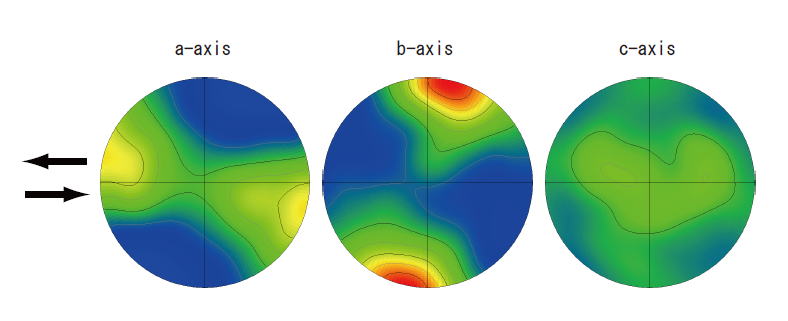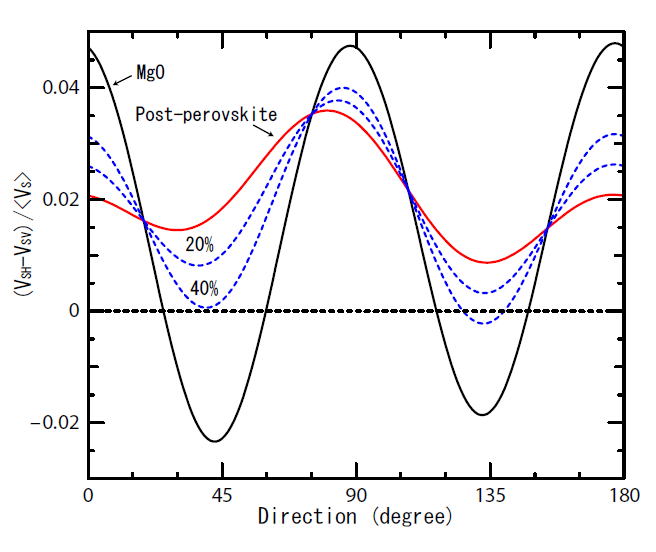| description | ||||
| Yamazaki D., Yoshino T., Ohfuji H., Ando J., Yoneda A., Origin of seismic anisotropy in the D″layer inferred from shear deformation experiments on post-perovskite phase, Earth Planet. Sci. Lett., 252, 372–378, 2006. | back | Full text | ||
| Seismic anisotropy is one of the significant features in the D" layer
of the Earth and is thought to be derived from the lattice preferred orientation
(LPO) of constituent materials or shape preferred orientation (SPO) of
heterogeneous materials such as melt and inclusions. Recent experimental
and theoretical studies strongly suggest that the D" layer consists
mainly of a MgSiO3 post-perovskite phase together with ferro-periclase. The microstructures
and crystallographic features of MgSiO3 post-perovskite recovered from high pressure and high temperature experiments
cannot be studied, however, due to it being in an unstable and unquenchable
phase at ambient conditions. Among all the post-perovskite-type oxides
(ABO3; space group: Cmcm) presently known, CaIrO3 is the only material that maintains the post-perovskite structure at ambient
conditions. The slip system and LPO pattern depend strongly on crystal
structure, but not on chemistry. To better understand the anisotropy in the D" layer, we have conducted a series of simple shear deformation experiments at high temperature and pressure on polycrystalline CaIrO3 as an analogue of MgSiO3 by using a modified Griggs type deformation apparatus and measuring the LPO of the post-perovskite phase. Crystallographic orientation analysis (the EBSD technique) of the deformed post-perovskite phase showed strong LPOs, with the dominant slip system being [100](010) (Fig. 1). Calculation of the elastic wave velocities, taking into consideration the effect of the LPOs of post-perovskite and ferro-periclase, showed azimuthal and polarization anisotropies in the shear plane, where the velocity of the horizontally polarized S-wave is considerably faster than that of the vertically polarized S-wave (Fig. 2). From seismological observations in the circum-Pacific region, the horizontally-polarized S-wave velocities (VSH) in the horizontal path are faster (by ~3%) than the vertically polarized ones (VSV). In view of recent mantle convection models, the horizontal flow may be the dominant deformation geometry in these regions. Thus, the seismic anisotropy observed in the D" layer can be reasonably explained by the LPO of the mixture of post-perovskite and ferro-periclase, where the LPO may result from the horizontal shear flow.  Fig. 1. Pole figures of the crystallographic orientation (a-, b-, and c-axes) for deformed CaIrO3 post-perovskite. The east-west direction corresponds to the shear direction, and the north and south poles correspond to the shear plane normal. Shear sense is indicated by arrows (top to left). Color coding refers to the density of the data points (warmer colors correspond to higher density, and cooler colors correspond to lower density).  Fig. 2. Azimuthal variation of the polarization anisotropy of S-waves in the horizontal shear plane of the deformed post-perovskite phase and ferro-periclase (solid lines) calculated based on the LPO data obtained in this study and a previous study (Yamazaki and Karato, 2002), respectively. Dashed lines show estimated anisotropy for a mixture of post-perovskite and ferro-periclase (20 and 40 vol% for ferro-periclase). Zero degree corresponds to the shear direction. |
||||
| top | members | outline | education | facilities | publications | links |